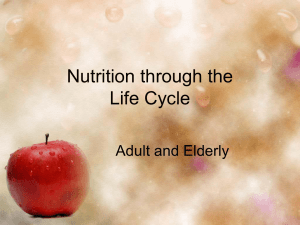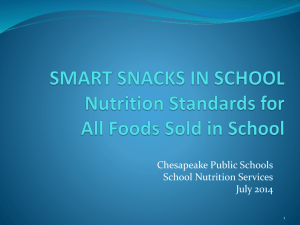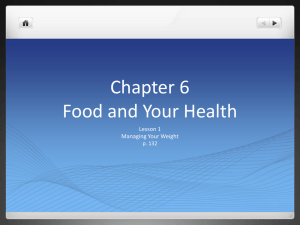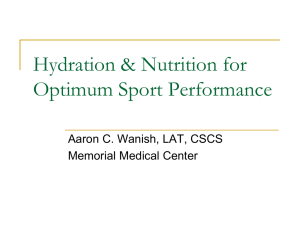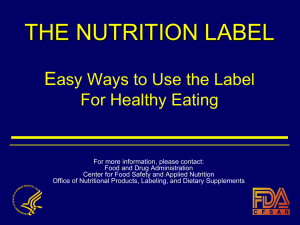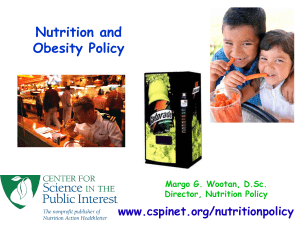Tactical Nutrition Brief
advertisement
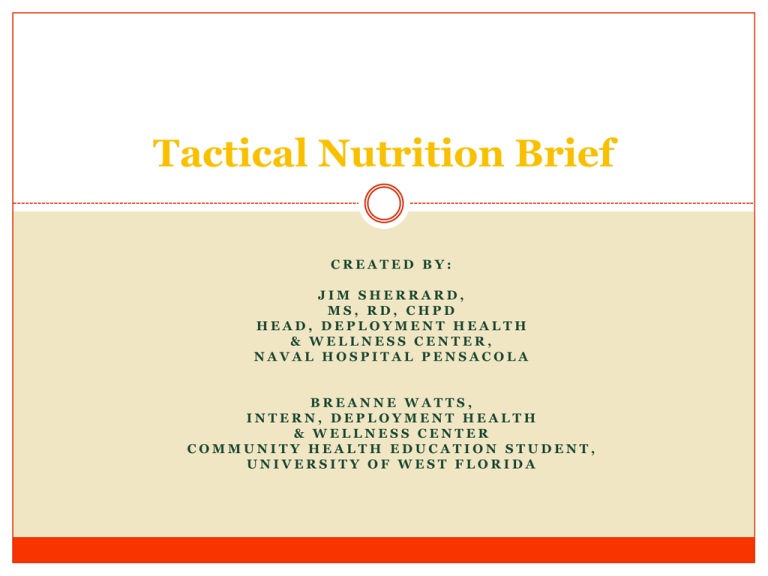
Tactical Nutrition Brief CREATED BY: JIM SHERRARD, MS, RD, CHPD HEAD, DEPLOYMENT HEALTH & WELLNESS CENTER, NAVAL HOSPITAL PENSACOLA BREANNE WATTS, INTERN, DEPLOYMENT HEALTH & WELLNESS CENTER COMMUNITY HEALTH EDUCATION STUDENT, UNIVERSITY OF WEST FLORIDA Table of Contents Introduction to Nutrition & Physical Activity Facts & Statistics 5 Fundamentals of Nutrition The Big Three MRE’s 10 Nutrition Tips to Live by Balancing Calories Portion Control Sum it Up Resources “…providing or obtaining food necessary for health and growth” NUTRITION Nutrition Why is Nutrition Important? Diet and body weight are related to health status Reduce the risks for many health conditions Essential to daily performance and military occupation Conditions: Overweight & obesity Iron-deficiency anemia Malnutrition Osteoporosis Type 2 diabetes Oral disease Heart disease Constipation High blood pressure Diverticular disease Dyslipidemia (poor lipid profiles) Some cancers “…any bodily activity that enhances or maintains physical fitness and overall health or wellness” PHYSICAL ACTIVITY Physical Activity Why is physical activity important? Regular physical activity can improve the health and quality of life of Americans of all ages, regardless of the presence of a chronic disease or disability Can also lower the risk for many health conditions Conditions: Early Death Stroke Coronary heart disease High blood pressure Type II Diabetes Breast & Colon Cancer Falls Depression Table of Contents Introduction to Nutrition & Physical Activity Facts & Statistics 5 Fundamentals of Nutrition The Big Three MRE’s 10 Nutrition Tips to Live by Balancing Calories Portion Control Shopping List Resources Facts & Statistics • MORE THAN 80 PERCENT OF ADULTS DO NOT MEET THE GUIDELINES FOR BOTH AEROBIC AND MUSCLE-STRENGTHENING ACTIVITIES. • MORE THAN TWO-THIRDS (68.8 PERCENT) OF ADULTS ARE CONSIDERED TO BE OVERWEIGHT OR OBESE. • MORE THAN ONE-THIRD (35.7 PERCENT) OF ADULTS ARE CONSIDERED TO BE OBESE. CDC Facts & Statistics • IN 2008, ONLY 37% OF MILITARY PERSONNEL MET THE HEALTHY WEIGHT CRITERION (BMI ≥18.5 AND <25.0), WHICH IS NOTABLY BELOW THE HEALTHY PEOPLE 2010 OBJECTIVE OF ≥60% • COMPARED WITH RATES FOR CIVILIANS, HEAVY ALCOHOL USE IS HIGHER FOR MILITARY. • AMONG THE USE OF ILLICIT DRUGS, SMOKING TOBACCO, AND ALCOHOL, MILITARY PERSONNEL SHOWED THE HIGHEST RATES OF HEAVY ALCOHOL USE • IN 2008, 13% OF MILITARY PERSONNEL CONSUMED THREE OR MORE SERVINGS OF FRUITS PER DAY, AND 14% CONSUMED THREE OR MORE SERVINGS OF VEGETABLES PER DAY • (notably lower than the Healthy People 2010 objectives of ≥75% for fruits and ≥50% for vegetables) DoD HRB Survey 2008 Table of Contents Introduction to Nutrition & Physical Activity Facts & Statistics 5 Fundamentals of Nutrition The Big Three MRE’s 10 Nutrition Tips to Live by Balancing Calories Portion Control Sum it Up Resources EAT CLEAN EAT OFTEN HYDRATE MINDSET RECOVER 5 Fundamentals of Nutrition NOFFS Eat Clean Try to eat foods in the most natural form possible Eat foods closest to their original form Least processed types of food, most of the time Think Nutrient Density Foods with more nutrients but less calories Carbohydrate, Protein, & Fat Eat Often Key to Energy & Sustainability Timing of meals Eat mini meals every 2-3 hours Maintains energy levels Helps to maintain focus Prevents becoming overly hungry Better choices Stabilizes blood sugar Boosts metabolism Keeps body in fat burning zone Hydrate WATER… • • • • • • • • • • • • Performance essential Aids in digestion/metabolism Brain function Regulating temperature Regulates body temperature Carries nutrients & oxygen cells Provides life & shape to every cell Shock absorption for spine & brain Cushions joints Weight Management Delivery of fuel to muscles 60-65% of total body weight is water Mindset Behavior change Lifestyle versus diet 80/20 rule Use tools & resources available to you Focus on results, they are rewarding Recover Don’t Waste Your Workout! Nutrition Can help to speed the recovery process Empty fuel stores & broken down muscles need to be re-fueled and repaired Combination of carbohydrates & proteins within 30 minutes ensures a fast recovery. Helps minimize time needed between workouts Decreases the risk of injury Carbohydrates = Re-fuel Protein = Re-build Table of Contents Introduction to Nutrition & Physical Activity Facts & Statistics 5 Fundamentals of Nutrition The Big Three MRE’s 10 Nutrition Tips to Live by Balancing Calories Portion Control Sum it Up Resources The Big Three Macronutrients: CARBOHYDRATE 4kcals/gram PROTEIN 4kcals/gram FAT 9kcals/gram Daily Recommended Amounts: Carbohydrates 4 kcals/gram Body is programmed to use glucose for energy Primary fuel source for hard exercise Faster recovery Maintains immune function Postpones fatigue GRAINS: “Come Back to Earth” Fuel for the brain & muscles Look for the least processed form of grain Think brown & found close to the ground! The best choices will have >3grams of fiber per serving 2 Main Groups of CHO: •Complex: Natural “sugars” •Whole grains, Milk, Fruits, Vegetables •Simple: Added “sugars” •Refined sugars added to food, Candy, Soda, Pastries, Cake, & Cookies Carbohydrates Too Much Carbohydrate? Leads to health problems Tired Feeling Obesity Type II Diabetes Excess of glucose in blood Builds resistance to insulin Gastrointestinal Distress Triglyceride Levels Plaque build up in arteries Increase Cholesterol levels Increased risk of heart attack and stroke Protein 4 kcals/gram Poor source of Energy Used for Growth, Maintenance, & Repair Forms enzymes, hormones, antibodies Supports structure of muscles and cells Made up of amino acids 20 total amino acids 9 essential- must be supplied by the diet 11 non essential- body can produce Protein How much Protein do you need? RDA for Protein = 0.8 grams/ kg of BW Athletes can range from 0.8 – 1.5 Calculate your requirement: • Take your weight in pounds / 2.2 = wt in kg • Weight in kg x .8 = protein requirement • Example: 180lbs / 2.2 = 81.8 x .8 = 65 grams of protein Too Much Protein? Excess amino acids cannot be stored in the body as protein More protein ≠ More muscle! Muscle strength, size, and shape comes from exercise Excess protein (any excess calorie) is stored as fat Too much protein can result in nutrient imbalance, kidney strain, dehydration, and excess body weight Fats 9 kcals/gram Provides essential nutrients (fatty acids), vitamins and some energy Lines and insulates the nerves of the brain and body organs Aids in manufacturing of antibodies Regular training improves your body’s ability to use fat as a fuel source “Fat burns in a carbohydrate flame” Fats Trans Saturated Unsaturated Too Much Fat? Leads to health problems including: • • • • • • • Overweight/Obesity Diabetes Heart Disease Atherosclerosis Bone Conditions Some cancers Stroke The Big Three CARBOHYDRATEfuel for the brain & muscles “Come back to Earth” ________ PROTEIN- building blocks for our bodies “The Less Legs the Better” ________ FAT- healthy fats = energy density “Eat Healthy Fat” Table of Contents Introduction to Nutrition & Physical Activity Facts & Statistics 5 Fundamentals of Nutrition The Big Three MRE’s 10 Nutrition Tips to Live by Balancing Calories Portion Control Sum it Up Resources Meals Ready to Eat (MRE) Each MRE contains: • • • • • • • • Entrée Side Dish Crackers / Bread Spread Dessert Candy Beverages Hot Sauce / Seasoning Totally self contained complete meal. • One MRE = One Meal Meals Ready to Eat (MRE) •Each MRE contains an average of: 1250 calories 13% Protein 36% Fat 51% CHO 1/3 of the Military Recommended Daily Allowance •24 “Menus” •4 Vegetarian Meals •3 MREs/day are recommended for active duty on patrols or on the front line. (3750 kcals) Table of Contents Introduction to Nutrition & Physical Activity Facts & Statistics 5 Fundamentals of Nutrition The Big Three MRE’s 10 Nutrition Tips to Live by Balancing Calories Portion Control Sum it Up Resources 10 Nutrition Rules for a Healthy Life 1. Come back to Earth Choose the LEAST processed forms of food such as: Fruits Veggies Whole grains High-fiber carbohydrates • Organic • USDA approved • All-Natural • Read your ingredients! 2. Eat a Rainbow Often Eat FRUITS & VEGETABLES with EACH MEAL Drink fruit juice in moderation Make sure it’s 100% juice Whole fruits & vegetables are best Canned/Frozen are a healthy alternatives at a lower cost Choose a wide variety of colors for the biggest benefit Have fun with it! 3. The Less Legs the Better Include a lean protein source with each meal > 4. Eat Health Fats Include healthy fats in your diet! Olive oil, nuts, natural nut butters, seeds, avocado, fish, flaxseed and flaxseed oil 5. Eat Breakfast Every Day Set the Tone! “Break” – “The” – “Fast” Breakfast Should Include: Breakfast: Protein: Eggs, egg whites, Increases Metabolism Fuels the Brain Increases Energy Levels Don’t substitute coffee, soda and energy drinks for food or lack of sleep. Skipping breakfast leads to eating more calories through the day and later at night. Don’t play catch up! ham, beans, yogurt, or lowfat milk High Fiber Carbohydrate: Whole wheat bread, high fiber cereal, oatmeal, or beans Color: Fruit in cereal, oatmeal, or yogurt / Veggies in eggs or omelets 6. Three for Three 3 meals & 2-3 snacks Eat smaller portions Eat more throughout the day You should be eating 4-6 times per day! Aim for all 3 macronutrients [carbs, protein, & fat] Eat every 3 hours for optimal fueling! 7. Stay Hydrated Dehydration = Decreased Performance Drink at least 3 liters of non-caloric beverages every day If you are thirsty, it is too late Water should be your main source of hydration Avoid drinking soda, energy drinks, and fruit drinks. Limit sweetened teas and coffee drinks with added sugar and cream *Evaluate urine to monitor hydration levels Only choose sports drinks before, during, and after INTENSE exercise 7. Stay Hydrated Water Requirement by Body Weight (ounces of fluid or liters per day) 120 pounds: ARMY TROOP REQUIREMENTS: • 1 quart of beverage per 1,000 calories expended 60 – 120 oz, 2 – 4 liters/day 150 pounds: 75 – 150 oz, 2.5 – 5 liters/day 175 pounds: 90 – 175 oz, 3 – 6 liters/day 200 pounds: 100 – 200 oz, 3.5 – 7 liters/day 225 pounds: 115 – 225 oz, 4 – 8 liters/day Increase water consumption: • in warm temperatures • at high altitudes • when wearing heavy clothing/gear • with increased levels of physical activity (Typically 4-6 quarts/day in these conditions) 250 pounds: 125 – 200 oz, 4.5 – 9 liters/day U.S. Army Public Health Command 8. Don’t Waste Your Workout During Workout Pre-Workout Gives you energy for your workout • • Increase intensity of workout Increase calories burned during exercise = weight loss Eat ½ -2 hrs before exercise Simple and bland carbohydrate rich meal Handful of trail mix Protein oatmeal + fruit Fruit smoothie Stay Hydrated • • Water! >1 hour: Use a drink that has electrolytes with a small amount of carbohydrate Ex. Gatorade, Diluted fruit juice Eat if exercise lasts longer than 60 minutes • • • • Prevents hitting the wall Helps maintain electrolyte balance .5 g CHO/lb. body weight per hour Ex. 4 cups of sports drink & banana 8. Don’t Waste Your Workout Post-Workout Makes up one of your 5-6 meals Best results- immediately or up to 30 minutes after workout Recovery snack or shake [granola bar or fruit smoothie] At least 5g of protein Recovery in 3’s Re-fuel: the more intense the training, the more CHO you need! Re-build: protein needs post workout are based on body weight (handout from earlier) Re-hydrate: drink 20-24oz of Combine carbs & protein fluid for each pound lost during training 8. Don’t Waste Your Workout What do you need to recover? Body Weight (in pounds) Grams of Grams Protein of CHO 120-150 15-20 30-60 150-180 20-25 40-75 180-215 25-30 50-90 215-245 30-35 60-105 More Examples: 20oz low-fat chocolate milk + banana Turkey and pasta salad Tuna sandwich w/baked chips Meal replacement bar + 20oz sports drink Scrambled eggs or egg whites with whole wheat toast and 6oz juice Turkey sandwich + yogurt Spaghetti and meatballs Fruit smoothie blended with yogurt or whey protein 9. Supplement Wisely FUEL FIRST, SUPPLEMENT SECOND What is a dietary Supplement? A product that is taken by mouth that contains a “dietary ingredient” intended to supplement the diet. Dietary Ingredients in these Add a multivitamin to daily routine if needed Check 1st with doc or registered dietician products: Vitamins, minerals, herbs, botanicals, amino acids, enzymes, organ tissues, gland tissue or secretions. No government testing required for: Hoodia and lead Hydroxycut and liver damage Choose smart Improve performance without compromising health Can be expensive 9. Supplement Wisely ENERGY DRINKS = BAD NEWS! Increase Heart Rate Increase Blood Pressure Dehydrate the Body Never Use when Exercising • Combination of fluid loss from sweating and the diuretic quality of the caffeine can leave the user severely dehydrated! 9. Supplement Wisely WARNING SIGNS OF QUACKERY Quick weight loss or muscle gain Restriction of any one food or food group Very low in calories (VLCD) • 800-1200 calories a day Claims that sound too good to be true You can eat all you want Promises an easy solution Breakthrough findings Check Food & Drug Administration website if unsure! 9. Supplement Wisely People are looking for: Extra Edge Better Results Easy way out Quick results with minimum effort Supplement Companies: Great marketing schemes Deceptive No regulation “The Magic Bullet” People are willing to pay! >$30 billion a year industry 9. Supplement Wisely Do your Research! • Before purchasing & ingesting any supplement, ask yourself: Is there research done on humans? • Double blind, placebocontrolled trials Will this help me achieve my performance goals? Will this compromise my health & well-being? Does this product have any medication interactions? 10. Sleep Aim for 8 hours of sleep daily If can’t get 8 hours, consider power naps when possible Body recovers & repairs best when sleeping Health conditions are associated with lack of sleep i.e. memory, cognitive impairment, injuries, stress, obesity, etc. Essential for performance i.e. energy, alertness, etc. Table of Contents Introduction to Nutrition & Physical Activity Facts & Statistics 5 Fundamentals of Nutrition The Big Three MRE’s 10 Nutrition Tips to Live by Balancing Calories Portion Control Sum it Up Resources Balancing Calories Formulas: See handout Men 10 x weight (kg) + 6.25 x height (cm) - 5 x age (y) + 5 Women 10 x weight (kg) + 6.25 x height (cm) - 5 x age (y) - 161 Find out how many calories you need in a day Mifflin St Jeor Equation Daily Caloric Needs Calculator Created in 2005 by American Dietetic Association (ADA) Most accurate Balance Weight= Calories Eaten & Calories Burned are equal Weight Gain= Calories Eaten > Calories Burned Weight Loss= Calories Eaten < Calories Burned NEVER… Eat a carb alone, skip meals, or go >4 hours without eating! Alcohol 7 kcals/gram Not a macronutrient Poor source of fluids – dehydrates Decreases the absorption of vitamins Can displace nutrient dense foods in the diet Decreases appetite Depletes the liver’s glycogen stores and impairs its capacity to form new glucose Empty Calories !! 1.5 fl oz. 12 fl oz. 5 fl oz. Alcohol One 12 oz. beer has 103 calories. Did you ever stop and think about how many calories are in 6 beers? 618 calories! Alcohol One Rum and Coke has 240 Calories. Did you ever wonder how many calories were in 6 Rum and Cokes?? 1,440 calories! Table of Contents Introduction to Nutrition & Physical Activity Facts & Statistics 5 Fundamentals of Nutrition The Big Three MRE’s 10 Nutrition Tips to Live by Balancing Calories Portion Control Sum it Up Resources Portion Control Choose MyPlate Portion Control Table of Contents Introduction to Nutrition & Physical Activity Facts & Statistics 5 Fundamentals of Nutrition The Big Three MRE’s 10 Nutrition Tips to Live by Balancing Calories Portion Control Time to Sum it Up! Resources Make Wise Choices Grilled > Fried Fruit > Candy or Dessert 2% Milk > Whole Milk Flavored Water > Soda Whole Wheat/Multi Grain vs. White Bread Apple or Carrots > Chips For a Snack Corn > Flour Tortilla Turkey > Pork Chicken > Beef Read the Label! Pay attention to serving size, may not be entire package! The more fiber, the better Monitor your fats, carbohydrates, and protein Limit sugars when possible Manage your fats < 65g/day Watch your sodium < 2,300mg/day *may vary with weight, age & activity levels Take Small Steps! Making a drastic change in your eating & exercise habits may lead to a stomach ache or injury. It also may lead to failure. However, making small steps along the way increases the chances you will stay! Table of Contents Introduction to Nutrition & Physical Activity Facts & Statistics 5 Fundamentals of Nutrition The Big Three MRE’s 10 Nutrition Tips to Live by Balancing Calories Portion Control Sum it Up Resources Government Resources www.commissaries.com http://willinteractive.com/products/ comprehensive-soldier-fitness United States Army Public Health Command QUESTIONS ? THANK YOU! DON’T FORGET TO TAKE THE POST TEST
